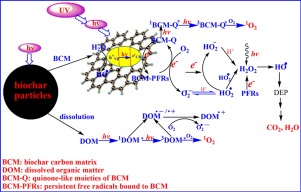Applied Catalysis B: Environment and Energy ( IF 20.2 ) Pub Date : 2017-05-11 , DOI: 10.1016/j.apcatb.2017.05.036 Guodong Fang , Cun Liu , Yujun Wang , Dionysios D. Dionysiou , Dongmei Zhou

|
In this study, the photogeneration of reactive oxygen species (ROS) from biochar suspension was investigated. The characterizations of biochar particles before and after photochemical reactions were analyzed by using FTIR, Raman, XPS and electron paramagnetic resonance (EPR) techniques. It was found that the model pollutant diethyl phthalate (DEP) was efficiently degraded and partially mineralized under UV and simulated solar lights in biochar suspension, with hydroxyl radicals (OH) and singlet oxygen (1O2) as the dominant ROS. EPR coupled with chemical probe methods and free radical quenching studies were used to quantify and elucidate the formation mechanism of
OH and 1O2. The results indicated that biochar carbon matrix (BCM) accounted for 63.6%–74.6% of
OH and 10%–44.7% of 1O2 formation, while dissolved organic matter (DOM) derived from biochar generated 46.7%–86.3% of 1O2 and 3.7%–12.5% of
OH. BCM-bound persistent free radicals (BCM-PFRs) and quinone-like structure of BCM (BCM-Q) were the predominant factors affecting
OH and 1O2 formation from BCM under light. Detailed ROS generation pathways are proposed as: (i) DOM from biochar particles contributes to
OH and 1O2 formation via light-induced energy and electron transfer processes; (ii) BCM-Q forms excited triplet states (3[BCM-Q]*) under light irradiation and induces the formation 1O2; (iii) UV promotes the formation of BCM-PFRs, which transfer electrons to oxygen to form superoxide anion radical (O2
−), further yielding H2O2; and (iv) H2O2-dependent pathways including BCM-PFRs activation and photo-Fenton reaction are primarily responsible for
OH production. Furthermore, BCM exhibits the excellent reusability towards DEP degradation during the three cycles under light.
中文翻译:

生物炭悬浮液中活性氧物种的光生降解邻苯二甲酸二乙酯
在这项研究中,研究了生物炭悬浮液中活性氧(ROS)的光生化。使用FTIR,拉曼光谱,XPS和电子顺磁共振(EPR)技术分析了光化学反应之前和之后的生物炭颗粒的特征。结果发现,该模型污染物邻苯二甲酸二乙酯(DEP)被有效降低,并且在UV下部分矿化和在生物炭悬浮模拟太阳灯,与羟基自由基(OH)和单线态氧(1 Ò 2)作为主要ROS。EPR结合化学探针方法和自由基猝灭研究用于定量和阐明
OH和1 O 2的形成机理。结果表明占63.6%-74.6%的,生物炭的碳基质(BCM)
OH和10%-44.7%的1 Ò 2形成,而从生物炭衍生溶解有机物质(DOM)产生46.7%-86.3%的1 ö 2和3.7%–12.5%的
OH。BCM结合的持久性自由基(BCM-PFRs)和BCM的醌样结构(BCM-Q)是影响BCM在光照下形成
OH和1 O 2的主要因素。详述ROS产生途径被提出作为:从生物炭颗粒有助于于(i)DOM
OH和1所ö 2形成经由光诱导的能量和电子转移过程;(ii)BCM-Q在光照射下形成激发三重态(3 [BCM-Q] *)并诱导形成1 O 2;(ⅲ)促进UV BCM-PFRS的形成,其中转印电子氧气以形成超氧阴离子自由基(O 2
- ),进一步产生ħ 2 ö 2 ; (iv)H 2 O 2依赖性途径,包括BCM-PFRs活化和光芬顿反应,主要负责
OH的产生。此外,在光照下的三个循环中,BCM表现出极好的DEP降解可重用性。













































 京公网安备 11010802027423号
京公网安备 11010802027423号